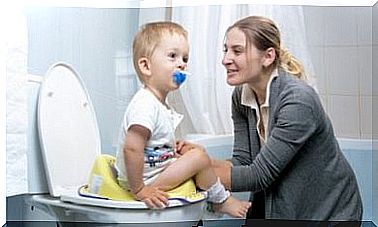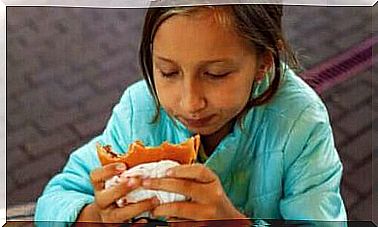A Baby’s Lack Of Appetite After They Are One Year Old

A baby’s eating habits change a lot after their first birthday. Even if parents offer the usual food, the child may now reject it and show no interest in eating it. This lack of appetite is related to age-related physical and mental changes. Many call it a loss of appetite.
From the first year of life, a child’s body grows more slowly than before. This occurs as a result of two independent processes. On the one hand, their metabolism ‘slows down’ with regard to the rhythm of the first months of life. And on the other hand, the level of physical activity increases, as does energy expenditure.
So should you be concerned if your baby is eating less than before after the age of one? Probably not. Here are some helpful tips to help you through this particular stage.
Characteristics of a baby’s physiological lack of appetite

Lack of appetite is to be expected at this age. According to estimates , about 30% of children aged 1 to 4 show some type of refusal to eat. However, only 1% of these have a disease (Lambrischini Ferri, 2007 – Spanish link).
It is common for toddlers to have difficulty eating. While not a health problem, it is a concern for parents and a source of family disputes at mealtimes.
One of the most prominent aspects of physiological lack of appetite is neophobia. This means ‘fear of the new’. It describes the tendency to avoid new foods. This condition is very rare in childhood, but peaks between 2 and 5 years of age and declines in adulthood.
Though somewhat cumbersome for parents, it is believed to be nothing more than a survival behavior of humans.
That’s because neophobia has a protective function. While people require a varied diet, the consumption of unfamiliar foods poses a risk of disease and toxicity (Rozin, 1976).
Therefore, to define food refusal as physiological, we must meet all of the following conditions:
- A healthy child who has not shown any signs or symptoms of digestive diseases.
- The child maintains a good progression with regard to weight and height, according to the references for their age and gender.
- The child maintains a level of activity and mood appropriate for his age.
What can you do about your child’s lack of appetite?
First of all, you should be aware that this is a temporary change that you can expect at this age. Just like you’ve had baby colic or breastfeeding crises, you’ll understand that no matter how hard it is to deal with, one day you’ll stop worrying.
Here are some helpful tips to put into practice when the situation gets complicated.
Calm and patience
The relationship between parents and children helps shape eating behavior. For this reason, the more tense the situation gets, the worse the outcome will be. And that applies not only to the quantity, but also to the quality of the food that the child eventually ingests.
To include a new food in a child’s diet, offer it at least 5 to 10 times over time. It is possible to adjust food preferences if we offer the food on different occasions (Birch, 1982).
Offer a variety of foods

All people have preferences for certain foods and that is not a bad thing at all. It is also true that we tend to copy the eating habits of our parents or siblings. This is the behavior we have been observing for years.
In addition to social context and mimicked behavior, there are genetic factors that play a role in food preferences.
In a study conducted by nutritionist Graciela Falciglia, she noted that the diets of children with more neophobia were more restrictive than those of children without neophobia. These restrictive diets, in turn, were significantly deficient in vitamins and high in saturated fats.
For this reason, it is important to offer all kinds of food whenever possible. One helpful way to accomplish this is to make sure there are plenty of colors and textures on your child’s plate. This way you ensure a good variety of nutrients.
Make food fun!
To have fun, the context must be appropriate. It is important to create a calm and relaxed atmosphere, without distractions (such as television or mobile phones), where everyone can enjoy the experience.
It is important to avoid quarrels during the meal or blame the child for, for example, eating too little or too slowly or selectively. We have to learn to respect their timing, their tastes and their desire to finish quickly in order to play again.
You should also be practical and not prolong the activity for too long. If your child ate their meal eagerly, even just a little, until it showed signs of fullness, then the meal should be considered ready at that point. Maybe they will stay at the table a little longer tomorrow.
It’s better without tricks
If the goal is to teach your child healthy eating habits, don’t focus on getting them to eat everything you have in mind today. Maybe over time they will do this… but it has to be on their own time.
It’s important to talk to your pediatrician or nutritionist about which nutrients are needed for each stage of life and which foods you can find them in. Sometimes your child does not need to drink a glass of milk as a source of calcium. Some vegetables, such as broccoli, can also provide all the calcium your child needs.
Mixing different ingredients in a soup or sauce is sure to provide a variety of nutrients. However, you certainly won’t learn healthy eating habits that way.
don’t force it
You don’t have to force your child to eat, nor should you threaten or bribe them. It is important to provide the child with food and the necessary conditions to adopt positive habits. Any action under pressure, on the other hand, can have negative consequences in the future.
About Your Baby’s Physiological Loss of Appetite
Now that you’ve learned that this behavior is to be expected in children ages 1 to 5, you can relax a little while eating. Remember to consult your pediatrician about healthy eating so as not to overlook certain aspects of infant nutrition.









